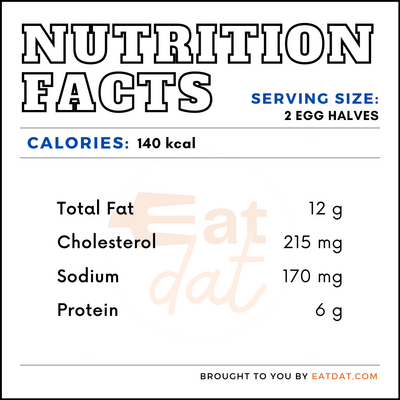
Deviled Eggs
also known as stuffed eggs, dressed eggs, or Russian eggs
What are Deviled Eggs?
Deviled eggs are a dish made using hard-boiled chicken eggs that have been sliced in half and stuffed with a filling of egg yolk and various ingredients. This dish is often garnished with:
Deviled eggs are usually eaten as a side dish or appetizer and are popular at parties. In 2019, the per capita egg consumption in the United States was 287.1. This egg dish is so well-liked that it is celebrated every year on November 2nd.
According to Sweety High, the top 10 most popular ways to eat eggs are:
- Poached
- Over Medium
- Over Easy
- Soft Boiled
- Deviled Eggs
- Baked
- Sunnyside Up
- Quiche
- Hard-Boiled
- Frittata
Origin of deviled eggs
This dish has its roots in ancient Roman dinner parties and were even referenced in Petronius’s “Satyricon” in 61 AD. The eggs that were described in this tale had peppered yolks and were stuffed inside of peahen eggs. Much later, in the 13th century, stuffed eggs prepared with pepper, cilantro, and other ingredients began to appear around Spain. By the 1400s, a variety of stuffed or deviled eggs could be found all over Europe.
In 1786, the Oxford English Dictionary defined “to devil” a food as cooking it with spicy seasoning over high heat. This is likely how this dish became known as deviled eggs. The first cookbook to mention using mayonnaise in this dish was the Boston Cooking-School Cookbook in 1896. However, using mayonnaise as the main binding ingredient didn’t become commonplace until the 1940s. Nowadays, most Americans use mayonnaise in this dish but there is a range of delicious versions of this dish all around the world.
Nutrition
Eggs are nutrient-rich and provide Vitamin A, choline, biotin, as well as antioxidants such as lutein and zeaxanthin. A very basic, no-frills rendition of this dish can have:

Doctors recommend that people who have high cholesterol or heart health issues limit their consumption of eggs. Although they provide a good source of protein, these eggs are not the most heart-healthy dish.
Commercial production
In recent years, the commercial production of eggs has notably increased. There are 340 million commercial laying hens in the US with the average hen producing 294 eggs per year. Hens can lay more eggs than ever because of advances in nutrition, disease prevention, and flock management. The state of Iowa produces more eggs than any other and has a total of 55,883,000 hens. Due to the food safety aspect of this product, they are not produced at scale. Most deviled eggs are prepared at the foodservice level, in restaurants and institutions.
Eggs are first boiled, cooled, peeled, and cut into half. The yolks are then mashed with mayonnaise, vinegar, mustard, salt, and pepper, and then filled back into the crevice of the whites. It is chilled before serving.
Uses
Storing eggs properly is vital to ensure they are safe to consume and free of any foodborne illnesses. Before making deviled eggs, it’s best to keep the eggs in their carton to protect them against strong odors and breakage. It’s also recommendable to store this food inside the refrigerator where it will stay cool at a constant temperature.
Cooking or heating eggs to 150° F for at least 12 minutes will ensure that any salmonella that may have been present is gone. You can also cook them at a lower temperature of 140° F for 78 to 83 minutes for the same effect. The USDA does not recommend consuming raw, unpasteurized eggs because of possible bacteria, as well as the increasing number of foodborne illnesses every year. This is especially dangerous for children or people with weakened immune systems.
Deviled egg ecipes
Eggs are a simple dish to make for get-togethers. Here are some popular recipes.
- Classic Deviled Eggs
- Hummus Deviled Eggs
- Smoked Eggs with Bacon
- Healthier Deviled Eggs
- Egg Salad Sandwich
FDA regulation
The Food and Drug Administration does not have any regulations concerning this dish but does provide egg safety rules. These rules are aimed at preventing illnesses and, in rare cases, death caused by eggs infected by salmonella. Eggs must be immediately refrigerated during storage and transportation. Commercial producers who have at least 3,000 hens or who do not pasteurize or treat eggshells are required to comply with this regulation. The FDA has estimated that following these rules can reduce the number of salmonella cases by 60%.
References
Schumm, Laura. “The Ancient History of Deviled Eggs.” History.com, History, 18 Apr. 2014, www.history.com/news/the-ancient-history-of-deviled-eggs.
“Deviled Eggs History: From Rome to Your Home.” Ncegg.org, North Carolina Egg Association, 25 Nov. 2019, ncegg.org/blog/deviled-eggs-history-from-rome-to-your-home/.
“Unscrambling the Message on Eggs.” Health.harvard.edu, Harvard Medical School, 1 July 2019, www.health.harvard.edu/heart-health/unscrambling-the-message-on-eggs.
“Egg Safety Final Rule.” U.S. Food and Drug Administration, FDA, 6 Apr. 2020, www.fda.gov/food/eggs-guidance-documents-regulatory-information/egg-safety-final-rule.
